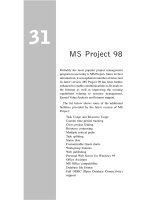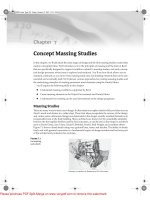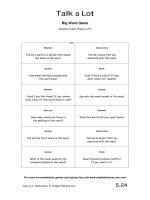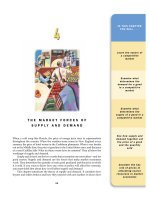Tài liệu Project Planning and Control Part 8 pptx
Bạn đang xem bản rút gọn của tài liệu. Xem và tải ngay bản đầy đủ của tài liệu tại đây (2.42 MB, 50 trang )
29
Example of integration of
tools and techniques
The example in this chapter shows how all the
tools and techniques described so far can be
integrated to give a comprehensive project man-
agement system. The project chosen is the
design, manufacture and distribution of a proto-
type motor car and while the operations and time
scales are only indicative and do not purport to
represent a real life situation, the examples show
how the techniques follow each other in a logical
sequence.
The prototype motor car being produced is
illustrated in Figure 29.1 and the main compo-
nents of the engine are shown in Figure 29.2. It
will be seen that the letters given to the engine
components are the activity identity letters used
in planning networks.
The following gives an oversight of the
main techniques and their most important
constituents.
As with all projects, the first document to be
produced is the Business Case which should also
include the chosen option investigated for the
Project Planning and Control
Investment Appraisal. In this exercise, the questions to be asked (and
answered) are shown in Table 29.1.
It is assumed that the project requires an initial investment of £60 million
and that over a 5 year period, 60 000 cars (units) will be produced at a cost of
£5000 per unit. The assumptions are that the discount rate is 8% and there are
two options for phasing the manufacture:
(a) That the factory performs well for the first two years but suffers some
production problems in the next three years (option 1);
(b) That the factory has teething problems in the first three years but goes into
full production in the last two (option 2).
The Discounted Cash Flow (DCF) calculations can be produced for both
options as shown in Tables 29.2 and 29.3.
To obtain the Internal Rate of Return (IRR), an additional discount rate (in
this case 20%) must be applied to both options. The resulting calculations are
290
Figure 29.1
Example of integration of tools and techniques
shown in Tables 29.4 and 29.5 and the graph showing both options is shown
in Figure 29.3. This gives an IRR of 20.2% and 15.4%, respectively.
It is now necessary to carry out a cash flow calculation for the distribution
phase of the cars. To line up with the DCF calculations, two options have to
be examined. These are shown in Tables 29.6 and 29.7 and the graphs in
Figures 29.4 and 29.5 for option 1 and option 2, respectively. An additional
option 2a in which the income in years 2 and 3 is reduced from £65 000K to
£55 000K is shown in the cash flow curves of Figure 29.6
All projects carry an element of Risk and it is prudent to carry out a risk
analysis at this stage. The types of risks that can be encountered, the possible
actual risks and the mitigation strategies are shown in Table 29.8. A risk log
(or risk register) for five risks is given in Figure 29.7
291
Figure 29.2 The parts of an overhead-camshaft engine
Project Planning and Control
Table 29.1
Business Case
Why do we need a new model?
What model will it replace?
What is the market?
Will it appeal to the young, the middle aged, families, the elderly, women, trendies,
yobos?
How many can we sell per year in the UK, the USA, the EEC and other countries?
What is the competition for this type of car and what is their price?
Will the car rental companies buy it?
What is the max. and min. selling price?
What must be the max. manufacturing cost and in what country will it be built?
What name shall we give it?
Do we have a marketing plan?
Who will handle the publicity and advertising?
Do we have to train the sales force and maintenance mechanics?
What should be the insurance category?
What warranties can be given and for how long?
What are the main specifications regarding
Safety and theft proofing?
Engine size (cc) or a number of sizes?
Fuel consumption?
Emissions (pollution control)?
Catalytic converter?
Max. speed?
Max. acceleration?
Size and weight?
Styling?
Turning circle and ground clearance?
What ‘extras’ must be fitted as standard?
ABS
Power steering
Air bags
Electric windows and roof
Cruise control
Air conditioning
What % can be recycled
Investment Appraisal (options)
Should it be a Saloon, Coup´e, Estate, People Carrier, Convertible, 4 × 4, Mini?
Will it have existing or newly designed engine?
Will it have existing or new platform (chassis)?
Do we need a new manufacturing plant or can we build it in an existing one?
Should the engine be cast iron or aluminium?
Should the body be steel, aluminium or fibreglass?
Do we use an existing brand name or devise a new one?
Will it be fuelled on petrol, diesel, electricity or hybrid power unit?
DCF of investment returns, NPV, cash flow?
292
Example of integration of tools and techniques
Table 29.2
DCF of Investment Returns (Net Present Value)
Initial Investment £60 000K 5 Year period
Total car production 60 000 Units @ £5000/Unit
Option 1
Year Production
Units
Income
£K
Cost
£K
Net Return
£K
Discount
Rate
Discount
Factor
Present Value
£K
1 15 000 100 000 75 000 25 000 8% 0.926 23 150
2 15 000 100 000 75 000 25 000 8% 0.857 21 425
3 10 000 65 000 50 000 15 000 8% 0.794 11 910
4 10 000 65 000 50 000 15 000 8% 0.735 11 025
5 10 000 65 000 50 000
15 000 8% 0.681 10 215
Totals 95 000 77 725
Net Present Value (NPV) = 77 725 – 60 000 = £17 725K
Profit = £95 000K – £60 000K = £35 000K
Average Rate of Return (undiscounted) = £95 000/5 = £19 000K per annum
Return on Investment = £19 000/£60 000 = 31.66%
293
Table 29.3
DCF of Investment Returns (Net Present Value)
Initial Investment £60 000K 5 Year period
Total car production 60 000 Units @ £5000/Unit
Option 2
Year Production
Units
Income
£K
Cost
£K
Net Return
£K
Discount
Rate
Discount
Factor
Present Value
£K
1 10 000 65 000 50 000 15 000 8% 0.926 13 890
2 10 000 65 000 50 000 15 000 8% 0.857 12 855
3 10 000 65 000 50 000 15 000 8% 0.794 11 910
4 15 000 100 000 75 000 25 000 8% 0.735 18 375
5 15 000 100 000 75 000
25 000 8% 0.681 17 025
Totals 95 000 74 055
Net Present Value (NPV) = 74 055 – 60 000 = £14 055K
Profit = £95 000K – £60 000K = £35 000K
Average Rate of Return (undiscounted) = £95 000/5 = £19 000K per annum
Return on Investment = £19 000/£60 000 = 31.66%
Project Planning and Control
294
Table 29.4
Internal Rate of Return (IRR)
Option 1
Year Net
Return
Disc.
Rate
Disc.
Factor
Present
Value
Disc.
Rate
Disc.
Factor
Present
Value
£K £K £K
1 25 000 15% 0.870 21 750 20% 0.833 20 825
2 25 000 15% 0.756 18 900 20% 0.694 17 350
3 15 000 15% 0.658 9 870 20% 0.579 8 685
4 15 000 15% 0.572 8 580 20% 0.482 7 230
5 15 000 15% 0.497 7 455 20% 0.402 6 030
Totals 60 000 66 555 60 120
Less Investment
–60 000 –60 000
Net Present Value £6 555K £120K
Internal Rate of Return (from graph) = 20.2%
Table 29.5
Internal Rate of Return (IRR)
Option 2
Year Net
Return
Disc.
Rate
Disc.
Factor
Present
Value
Disc.
Rate
Disc.
Factor
Present
Value
£K £K £K
1 15 000 15% 0.870 13 050 20% 0.833 12 495
2 15 000 15% 0.756 11 340 20% 0.694 10 410
3 15 000 15% 0.658 9 870 20% 0.579 8 685
4 25 000 15% 0.572 14 300 20% 0.482 12 050
5 25 000 15% 0.497 12 425 20% 0.402 10 050
Totals 60 000 60 985 53 690
Less Investment
–60 000 –60 000
Net Present Value £985K –£6 310K
Internal Rate of Return (from graph) = 15.4%
Example of integration of tools and techniques
Once the decision has been made to proceed with the project, a Project Life
Cycle diagram can be produced. This is shown on Figure 29.8 together with
the constituents of the seven phases envisaged.
The next stage is the Product Breakdown Structure (Figure 29.9), followed
by a combined Cost Breakdown Structure and Organisation Breakdown
Structure (Figure 29.10). By using these two, the Responsibility Matrix can be
drawn up (Figure 29.11).
It is now necessary to produce a programme. The first step is to draw an
Activity List showing the activities and their dependencies and durations.
295
Figure 29.3
Table 29.6
Cash Flow
Option 1
Year 1 2 3 4 5 Cumulative
Capital £K 12 000 12 000 12 000 12 000 12 000
Costs £K 75 000 75 000 50 000 50 000 50 000
Total £K 87 000 87 000 62 000 62 000 62 000 360 000
Cumulative 87 000 174 000 236 000 298 000 360 000
Income £K 100 000 100 000 65 000 65 000 65 000 395 000
Cumulative 100 000 200 000 265 000 330 000 395 000
Project Planning and Control
These are shown in the first four columns of Table 29.9. It is now possible to
draw the Critical Path Network in either AoN format (Figure 29.12), AoA
format (Figure 29.13) or as a Lester diagram (Figure 29.14).
After analysing the network diagram, the Total Floats and Free Floats of
the activities can be listed (Table 29.10).
296
Table 29.7
Cash Flow
Option 2
Year 1 2 3 4 5 Cumulative
Capital £K 12 000 12 000 12 000 12 000 12 000
Costs £K 50 000 50 000 50 000 75 000 75 000
Total £K 62 000 62 000 62 000 87 000 87 000 360 000
Cumulative 62 000 124 000 186 000 273 000 360 000
Income £K 65 000 65 000 65 000 100 000 100 000 395 000
Cumulative 65 000 130 000 195 000 295 000 395 000
Figure 29.4
Example of integration of tools and techniques
297
If income falls to £55 000K in years 2 and 3:
Income £K = 65 000 55 000 55 000 100 000 100 000
Cumulative = 65 000 120 000 175 000 275 000 375 000
Figure 29.5
Figure 29.6
Project Planning and Control
Apart from the start and finish, there are four milestones (days 8, 16, 24 and
30). These are described and plotted on the Milestone Slip Chart (Figure
29.15).
The network programme can now be converted into a bar chart (Figure
29.16) on which the resources (in men per day) as given in the fifth column
298
Table 29.8
Risk Analysis
Types of risks
Manufacturing (machinery and facilities) costs
Sales and marketing, exchange rates
Reliability
Mechanical components performance
Electrical components performance
Maintenance
Legislation (emissions, safety, recycling, labour, tax)
Quality
Possible risks
Won’t sell in predicted numbers
Quality in design, manufacture, finish
Maintenance costs
Manufacturing costs
New factory costs
Tooling costs
New factory not finished on time
Training problems
Suppliers unreliable
Rust proofing problems
Performance problems
Industrial disputes
Electrical and electronic problems
Competition too great
Not ready for launch date (exhibition)
Safety requirements
Currency fluctuations
Mitigation strategy
Overtime
More tests
More research
More advertising/marketing
Insurance
Re-engineering
Contingency
Figure 29.7
Copyright © 1996 WPMC Ltd. All rights reserved
Project Planning and Control
300
Figure 29.8
Figure 29.9
Example of integration of tools and techniques
of Table 29.9 can be added. After summating the resources for every day, it
has been noticed that there is a peak requirement of 12 men in days 11 and 12.
As this might be more than the available resources, the bar chart can be
adjusted by utilizing the available floats to smooth the resources and eliminate
the peak demand. This is shown in Figure 29.17 by delaying the start of
activities D and F.
301
Figure 29.10
Figure 29.11
Project Planning and Control
In Figure 29.18, the man days of the unsmoothed bar chart have been
multiplied by 8 to convert them into manhours. This was necessary to carry
out Earned Value Analysis. The daily manhour totals can be shown as a
histogram and the cumulative totals are shown as an ‘S’ curve. In a similar
way Figure 29.19 shows the respective histogram and ‘S’ curve for the
smoothed bar chart.
It is now possible to draw up a table of Actual Manhour usage and %
complete assessment for reporting day nos. 8, 16, 24 and 30. These, together
with the Earned Values for these periods are shown in Table 29.11. Also
shown is the efficiency (CPI), SPI, and the predicted final completion costs
and times as calculated at each reporting day.
Using the unsmoothed bar chart histogram and ‘S’ curve as a Planned
manhour base, the Actual manhours and Earned Value manhours can be
302
Table 29.9 Activity list of motor car engine manufacture and assembly (10
off), 8 hours/day
Activ.
letter
Description Dependency Duration
days
Men
per
day
Man
hours
per
day
Total
man
hours
A Cast block and cylinder head Start 10 3 24 240
B Machine block A 6 2 16 96
C Machine cylinder head B 4 2 16 64
D Forge and mc. flywheel E 4 2 16 64
E Forge crankshaft Start 8 3 24 192
F Machine crankshaft E 5 2 16 80
G Cast pistons A 2 3 24 48
H Machine pistons G 4 2 16 64
J Fit piston rings H 1 2 16 16
K Forge connecting rod E 2 3 24 48
L Machine conn. rod K 2 2 16 32
M Fit big end shells L 1 1 8 8
N Fit little end bush M 1 1 8 8
O Assemble engine B, F, J, N 5 4 32 160
P Fit flywheel D, O 2 4 32 64
Q Fit cylinder head C, P 2 2 16 32
R Fit camshaft and valves Q 4 3 24 96
Total
1312
Example of integration of tools and techniques
plotted on the graph in Figure 29.20. This graph also shows the % complete
and % efficiency at each of the four reporting days.
Finally Table 29.12 shows the actions required for the Close-Out
procedure.
303
Figure 29.12
Figure 29.13
Figure 29.14
Example of integration of tools and techniques
305
Table 29.10
Activity Floats
From CP network
Activ.
letter
Description Duration Total
float
Free
float
A Cast block and cylinder head 10 0 0
B Machine block 6 1 0
C Machine cylinder head 4 4 4
D Forge and mc. flywheel 4 10 10
E Forge crankshaft 8 3 0
F Machine crankshaft 5 4 4
G Cast pistons 2 0 0
H Machine pistons 4 0 0
J Fit piston rings 1 0 0
K Forge connecting rod 2 3 0
L Machine conn. rod 2 3 0
M Fit big end shells 1 3 0
N Fit little end bush 1 3 3
O Assemble engine 5 0 0
P Fit flywheel 2 0 0
Q Fit cylinder head 2 0 0
R Fit camshaft and valves 4 0 0
Figure 29.15
Days
Q
P
O
N
M
L
K
J
H
G
F
E
D
C
B
A
123
45
6
7
8 9 10 11 12 13 14 15 16 17 18 19 20 21 22 23 24 25 26 27 28 29 30 31 32 33 34 35
Total
Cum.
mday
6
6
6
12
6
18
6
24
6
30
6
36
6
42
6
48
9
57
9
66
12
78
12
90
7
97
5
102
4
106
4
110
4
114
6
120
6
126
6
132
4
136
4
140
4
144
4
148
2
150
2
152
3
155
3
158
3
161
3
164
3333333333
1
44444
44
22
3333
222
2
2
2
2
2
2
2
2
2
222
2222
33333333
2
2
2
2
222
3
3
3
3
1
Bar chart of prototype motor cars (10 off)
Days
Q
P
O
N
M
L
K
J
H
G
F
E
D
C
B
A
123
45
6
7
8 9 10 11 12 13 14 15 16 17 18 19 20 21 22 23 24 25 26 27 28 29 30 31 32 33 34 35
Total
Cum.
mday
6
6
6
12
6
18
6
24
6
30
6
36
6
42
6
48
5
53
5
58
8
66
8
74
7
81
7
88
6
94
6
100
6
106
6
112
8
120
8
128
6
134
6
140
4
144
4
148
2
150
2
152
3
155
3
158
3
161
3
164
3333333333
1
44
2
4
2
4
2
4
2
44
22
3333
222
2
2
2
2
2
2
2
2
2
2
2
2
2
222
33333333
22
2
3
3
3
3
1
Bar chart of prototype motor cars (10 off) After moving D to start at day 18
and moving F to start at day 12
Project Planning and Control
1 Business case
Need for new model. What type of car. Min./max. price. Manufacturing cost.
Units per year Marketing strategy. What market sector is it aimed at. Main
specification. What extras should be standard. Name of new model. Country
of manufacture.
306
Figure 29.16 Unsmoothed
Figure 29.17 Smoothed
Example of integration of tools and techniques
2 Investment appraisal
Options: Saloon, Coup´e, Estate, Convertible, People carrier, 4 × 4. Existing or
new engine. Existing or new platform. Materials of construction for engine,
body. Type of fuel. New or existing plant. DCF of returns, NPV, Cash flow.
3 Project and product life cycle
Conception: Original idea, submission to top management
Feasibility: Feasibility study, preliminary costs, market survey
Design: Vehicle and tool design, component tests
Prototype: Tooling, production line, environmental tests
Manufacture: Mass production, training
Distribution: Deliveries, staff training, marketing
Disposal: Dismantling of plant, selling tools
307
Figure 29.18
Project Planning and Control
4 Work and product breakdown structure
Design, Prototype, Manufacture, Testing, Marketing, Distribution, Training.
Body, Chassis, Engine, Transmission, Interior, Electronics.
Cost Breakdown Structure, Organization Breakdown Structure, Responsibility
Matrix.
5 AoN network
Network diagram, forward and backward pass, floats, critical path, examina-
tion for overall time reduction, conversion to bar chart with resource loading,
histogram, reduction of resource peaks, cumulative ‘S’ curve. Milestone slip
chart.
308
Figure 29.19
Table 29.11 Manhour usage of motor car engine manufacture and assembly (10 off) (unsmoothed)
Period
Act. Budget
M/H
Day 8
Actual
cum.
%
comp.
EV
Day 16
Actual
cum.
%
comp.
EV
Day 24
Actual
cum.
%
comp.
EV
Day 30
Actual
cum.
%
comp.
EV
A 240 210 80 192 260 100 240 260 100 240 260 100 240
B 96 30 20 19 110 100 96 110 100 96
C 64 70 100 64 70 100 64
D 64 60 50 32 80 100 64 80 100 64
E 192 170 80 154 200 100 192 200 100 192 200 100 192
F 80 70 80 64 90 100 80 90 100 80
G 48 54 100 48 60 100 48 60 100 48
H 64 60 80 51 68 100 64 68 100 64
J 16 16 100 16 16 100 16
K 48 52 100 48 52 100 48 52 100 48
L 32 40 100 32 40 100 32 40 100 32
M 8 6 80 6 8 100 8 8 100 8
N 8 6 80 6 8 100 8 8 100 8
O 160 158 90 144 166 100 160
P64 80 100 64
Q32 24 60 19
R96 52 40 38
Total 1312 380 346 838 738 1220 1104 1384 1241
% complete 26.3 56.2 84.1 94.6
Planned manhours 384 880 1184 1312
Efficiency (CPI) % 91 88 90 90
Est. final manhours 1442 1491 1458 1458
SPI (cost) 0.90 0.84 0.93 0.96
SPI (time) 0.90 0.86 0.92 0.89
Est. completion day 33 36 32 31
Project Planning and Control
310
Figure 29.20 Unsmoothed resources
Table 29.12
Close-out
Close-out meeting
Store standard tools
Sell special tools and drawings to Ruritania
Clear machinery from factory
Sign lease with supermarket that bought the site
Sell spares to dealers
Sell scrap materials
Write report and highlight problems
Press release and photo opportunity for last car
Give away 600 000th production car to special lottery winner
Example of integration of tools and techniques
6 Risk register
Types of risks: manufacturing, sales, marketing, reliability, components
failure, maintenance, suppliers, legislation, quality. Qualitative and quantita-
tive analysis. Probability and impact matrix. Risk owner. Mitigation strategy,
contingency.
7 Earned value analysis
EVA of manufacture and assembly of engine, calculate Earned Value, CPI,
SPI, cost at completion, final project time, draw curves of budget hours,
planned hours, actual hours earned value, % complete, efficiency over four
reporting periods.
8 Close-out
Close-out meeting
Close-out report
Instruction manuals
Test certificates
Spares lists
Dispose of surplus materials.
311
30
Hornet Windmill
Hornet Windmill is the latest version of the range
of Hornet Software for Project Management that
has been developed steadily over the past 20
years by Claremont Controls Ltd. This software
system is designed for use on PCs and provides a
high performance project planning and control
tool for use with virtually any type of project. In
its early versions the product was designed for
use on the character style DOS displays of the
first personal computers. Now current versions of
the system have taken the product forward onto
the Windows operating environment to provide a
highly interactive, yet flexible and powerful
management tool. Hornet Windmill may be used
in both the single-project and multi-project
environments, and includes an extremely power-
ful scheduling capacity and very comprehensive
and flexible reporting capability.
Over recent years all PC-based project man-
agement software systems have become more
interactive with direct entry of task details and
logic on tabular grids and bar chart displays.
Hornet Windmill is no exception as the following
brief summary of the system’s functionality
Hornet Windmill
shows. Additionally the Hornet range of software is unique in directly
supporting the management methods described by the author in earlier
chapters of this book – specifically the drafting and numbering of network
diagrams, and the SMAC Cost Control methodology. The following review
does not detail the product’s features and functions – space does not permit
this – but describes the range of facilities and the types of reporting that this
system offers. By way of example the manner in which the SMAC Cost
Control calculations are supported by Hornet Windmill is described.
The main display
The main display in Hornet Windmill is a combined data grid and interactive
bar chart display. The data values for the project tasks are displayed on the
grid section with task bars shown on the bar chart area.
Both sections of the display scroll vertically through the entire task list,
whilst the bar chart section can also be scrolled horizontally through time, and
the timescale contracted or expanded to show a larger or smaller slice of the
project duration.
313
Figure 30.1 Hornet Windmill title screen









